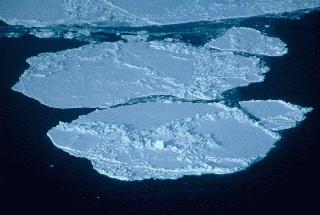Click on image for full size
Ute Kaden/PolarTREC
The Cryosphere and Global Climate Change
Most of us do not live in polar regions. We do not come in contact with icebergs or ice sheets very often. Most of us have only seen these things in photographs. However, no matter where you live, the snow and ice of the Earth’s cryosphere has an impact on your climate.
Recent changes in the cryosphere have had a major impact on global climate. This is because the cryosphere is an important part of the Earth system and because it is so interconnected with other parts of the Earth system. Scientists are currently studying just how much the frozen places on Earth affect global warming. Below are some of the ways that the cryosphere has been affecting climate change through interactions with other parts of the Earth system and feedbacks that increase the rate of global warming.
Melting Ice Causes More Warming
When solar radiation hits snow and ice approximately 90% of it is reflected back out to space. As global warming causes more snow and ice to melt each summer, the ocean and land that were underneath the ice are exposed at the Earth’s surface. Because they are darker in color, the ocean and land absorb more incoming solar radiation, and then release the heat to the atmosphere. This causes more global warming. In this way, melting ice causes more warming and so more ice melts. This is known as a feedback. According to a recent scientific study that used computer models to predict the future of Arctic sea ice, there may be no more sea ice left in the Arctic Ocean during summer within the next few decades.
Melting Permafrost Releases Greenhouse Gas
Global warming is causing soils in the polar regions that have been frozen for as much as 40,000 years to thaw. As they thaw, carbon trapped within the soils is released into the atmosphere as methane, a powerful greenhouse gas. The methane released to the atmosphere causes more global warming, which then melts more of the frozen soils.
Less Ice on Land Means Sea Level Rises
Sea level has been rising about 1-2 millimeters each year as the Earth has become warmer. Some of the sea level rise due to melting glaciers and ice sheets which add water to the oceans that was once trapped on land. Certain glaciers and ice sheets are particularly vulnerable. Global warming has caused them to be less stable, to move faster towards the ocean, and add more ice into the water. These areas with less stable ice include the Greenland Ice Sheet and the West Antarctic Ice Sheet. If the Greenland Ice Sheet melted or moved into the ocean, global sea level would rise approximately 6.5 meters. If the West Antarctic Ice Sheet were to melt or move into the ocean, global sea level would rise approximately 8 meters.















